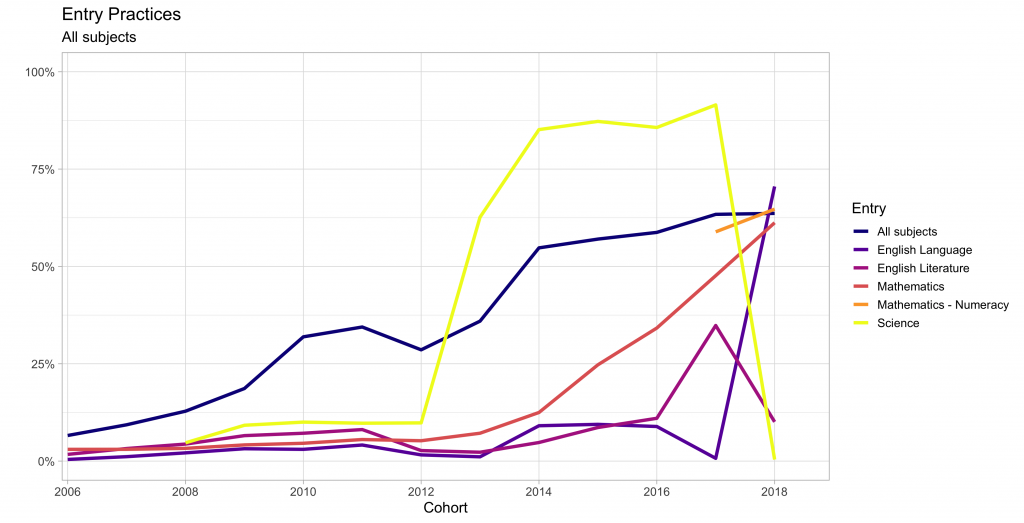Mae'r cynnwys hwn ar gael yn Saesneg yn unig.
GCSE entry practices in Wales have meant that many pupils may have sat their GCSE examinations, and thereby certified, before the traditional end-of-Year-11 point of their academic career. Not only have some pupils experienced early entry, some have been entered multiple times in order to maximise the final grade achieved. Influences on the practice of early and multiple entry have been shown to fall under two main categories: those concerned with individual pupil achievement and progression, and those concerned with overall school performance. Concerns have been raised that such practices may disadvantage some pupils, in a number of ways. Coupled with the financial burden that early entry places on secondary schools in Wales (estimated to be £3.3m in 2016/17), recent reforms have seen changes to school performance reporting to discourage the practice.
Using national data of all the pupils in Wales who completed Year 11 in 2006 – 2018, patterns of early GCSE entry were tracked over time. These patterns are shown in the figure below.

When we consider all subjects, we can see that there has been a relatively steady increase in the proportion of early entries, increasing from less than 10% to over 60%. Subjects which see the highest rates of early entry are Mathematics, Mathematics – Numeracy, English Language, English Literature, and Science.
As well as early entry patterns differing between these subjects, multiple entry patterns also differ. It was far more common for pupils to be entered multiple times for Mathematics and Mathematics – Numeracy than for the other subjects. This was particularly true for the last pupil cohorts in this analysis, with between a third and a half being entered more than once.
Early entry appears to be used in one of two ways. Pupils that are entered early, but only once appear to be ‘banking’ grades; getting a GCSE out of the way early so that they can concentrate on their other GCSEs in Year 11. For others that are entered early, this early entry is a first attempt so that they can enter again (and again) in order to try and get the best grade possible. This latter practice is likely to be particularly important for those who are performing around the Grade C threshold; multiple entry may be an important opportunity to improve from a D to a C grade.
Although not shown in the figure above, examination of the Year 10 entry data for the 2019 cohort suggests that changes to school performance reporting – where only the first entry counts – may have had the desired effect of discouraging early entry. Most of the GCSEs for which early entry has been common practice appear to have much lower proportions of early entry, apart from English Literature. Whilst we cannot confirm this until we have access to the Year 11 data for 2019 pupils, this appears to suggest a decrease in the proportion of early entries overall.
Read our blog discussing the effect that multiple entry has on grades.
———————–
About the WISERD Education Data Lab:
WISERD Education Data Lab undertakes independent analysis of administrative education data, survey data and data linkage, alongside knowledge exchange and public dissemination of findings to inform national debate on some of the most contemporary and pressing educational issues facing Wales.
WISERD Education Data Lab is funded by Welsh Government, Economic and Social Research Council (award: ES/012435/1) and Cardiff University.
The statistics used in this report have been approved for publication by SAIL. This does not imply Welsh Government’s acceptance of the validity of the methods used to obtain these statistics, or of any analysis of the results. Rather, they have been deemed to be non-disclosive (i.e. individual pupils cannot be identified).


